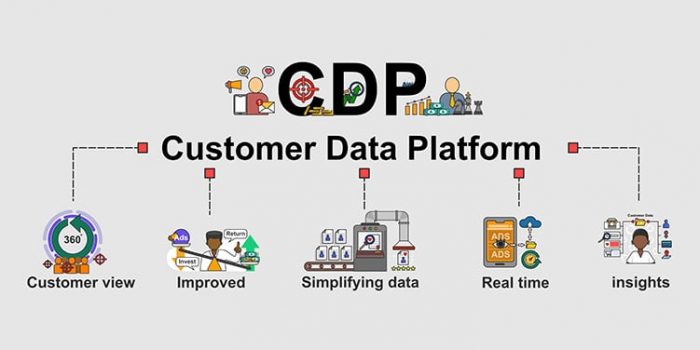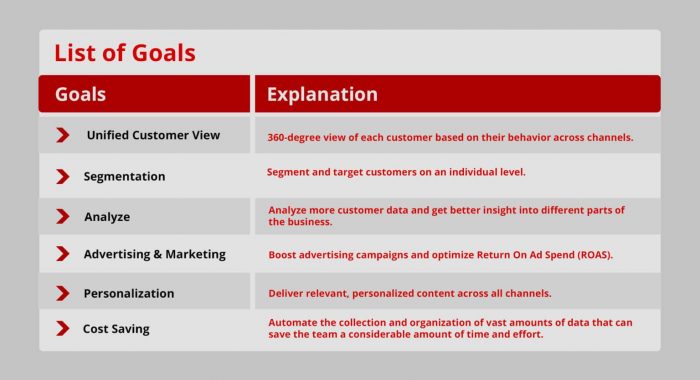
Customer Data Platforms (CDP) are next-gen technologies revolutionizing customer data storage, management, and unification. It seems like an overstatement until you look at the projected 36.4% customer data platform market growth between 2021 and 2026. With unmatched capabilities, CDPs are replacing Data Management Platforms in organizations focused on delivering the best customer experiences possible.
Marketers in every industry are trying to keep up with customer expectations and the tools needed to improve them. Still, the customer data platform market offers hundreds of options, with more to come, making the selection process complex and time-consuming. Whether you’re starting your search for a new CDP or the team’s first CDP, we’ve covered the essentials you’ll need to consider when sorting through options.
Not ready to begin your search? Read more about Adobe RT-CDP and it improves customer journey here.
Let’s start with the basics. Why do you need a CDP? What does a Customer Data Platform do? The answer to this question will guide your responses to later questions surrounding features, price points, organizational needs, goals, CDP best practices, and more.

Why Do You Need a CDP?
Since the first industry report dedicated to CDPs was published in 2013, vendors have created customer data platforms that vary in both subtle and obvious ways. What’s consistent with these options are the benefits promised to adopters. So, do you need a CDP? Do the benefits of a Customer Data Platform outweigh the integration’s cost or the time required to keep data clean?
It depends on what you’re looking for; a CDP can significantly impact your business’ data collection, storage, unification, and stitching, but what is most important and relevant to marketing’s goals at this point?
Evaluate Your Current Position
How you are managing your customer data right now and analyzing the efficiency behind this process is key to assessing your present situation, identifying what you’re missing out on and how a CDP can help.
Let’s find out how complex your data management system is and look at common problems faced by organizations across the board.
- Is current data storage siloed?
- Is this data sourced from first, second, and third parties?
- How are you accessing the data from different systems? Is it complex?
- Are you wasting your time and resources correcting data errors or deduplicating the data?
If any of your answers to the above question are yes, you need a CDP. Do not rely on customer relationship management (CRM) platforms or data management platforms (DMP) to do the work of a CDP.
Also, your stack should be structured to resolve these issues and increase the efficiency of your teams’ efforts. A disconnect leading to insufficient data not only wastes time, but it also costs money – think millions of dollars each year.
Once you’ve taken stock of all the ways data is accessed, stored, and collected within your organization and have pinpointed where problems are occurring, it’s time to look forward and plan for success.
Define Your Benchmark for a Successful CDP Implementation
Before adopting new technology, list out how you plan to utilize it. What goals do you hope to accomplish? When goals are clearly defined, it’s much easier to map out how to get there and measure your progress along the way. You can equate this step to identifying objectives and KPIs.
This provides a context for you to visualize CDP solutions and how they might impact your day-to-day and long-term goals. Here are a few steps to easily accomplish this task:
- Make a list of objectives and needs.
- List out which of these goals and needs the application will fulfill.
- From these two lists, summarize what each CDP solution offers, what you’re unsure of, and what it lacks.
- Run through the above steps once more, but with long-term goals in mind this time.
By doing this, you’ll gain comprehensive knowledge of each offering’s capabilities and drawbacks. You’ll then have a better grasp on what to expect upon any Customer Data Platform implementation and be able to knock at least a few vendors off of your list.

For example, an eCommerce company is always looking to enhance its customer experience. To achieve this, they widely depend on new innovative initiatives such as gift-related sales and retargeting ads. However, they end up with annoying ads, incompetent targets, and increased spending with minimal results. It is true that working with data from various sources is a real challenge. And, it seems the lack of a unified view of data is leading to the targeting of channels instead of people. Also, this view should be all-around accessible for time-sensitive marketing campaigns.
The company’s objective is to create a unified view of data and personalize marketing campaigns with relevant messages at the individual level. To achieve these goals, organizations need to manage customer data at scale. No doubt, Adobe RT-CDP is the standout solution for these issues. As it collects data from various sources and creates a single real-time view of customers’ data. As a result, it helps you deliver consistent and personalized customer experiences across every touchpoint.
TIP: Understand Your Data Maturity Level
To better understand potential goals and current needs, determine the status of your organization’s digital maturity. Digital maturity is the measurement of how efficiently you are using data to drive better results.
An accurate data maturity analysis can simplify this step and provide another goal of attaining the next level. Now with a complete understanding of organizational data, go deeper into your exploration of CDP solutions that remain on the culled list.
Explore the Top Players
At present, more than 150 CDP vendors saturate the market. So devote time to completing demos of each, reading reviews, asking questions, and discussing the ins and outs of each option with members of your team. The most popular CDP vendors – Salesforce, Adobe, and Tealium – are worth looking at but might not suit your group.
While these vendors’ solutions are widely used, and for good reason, they might not integrate with existing systems as seamlessly as others. So, this is something to keep in mind and research before making a purchase.
If you’re able to move forward with one of these or are already using other digital experience platform applications, Adobe Real-Time CDP and Salesforce CDP, also known as Salesforce Marketing Cloud, could be the way to go and push your business closer to becoming an Experience Business.
Include your teams and stakeholders in discussions to ensure you’re not overlooking any organizational goals or needs for the future.
Key Features to Look For in a CDP
Here are a few of the most helpful features to consider while selecting the right CDP based on the requirements of your team, organization, and customers:
- Look for real-time data ingestion through server-to-server communications. These days data is generated by machines such as IoT data and real-time. For that reason, your CDP must integrate data from various sources.
- The CDP you consider should create robust customer profiles by stitching known and unknown data. *Bonus points for any options maintaining a device graph.
- Choose a trusted real-time Customer Data Platform that complements your MarTech Stack. The CDP space is saturated and includes disparate technologies woven together to solve some primitive use cases.
- Your CDP must implement regulations such as GDPR, CCPA, and others. Look into its privacy features and whether these allow you to define employee roles and control data accessibility.
- Choose a CDP that offers real-time data sharing capabilities with activation channels. A CDP with open APIs will be more efficient as it will allow you to implement custom integrations.
There are other items to consider, too, such as having marketer-friendly UI and workflows. You can also go with a CDP that supports the addition of AI. Of course, it will take your audience management workflows and customer experiences automation to the next level.
What to Avoid
So far, we have mentioned everything you should consider, but there is one more item to be mindful of as you go through the process of “how to choose a CDP”. Avoid “Point CDPs” or point solutions that do not provide the same functionality as a CDP.
These often store data yet lack all the other features a modern marketer needs to excel. Every addition to your Martech stack should work with your existing solutions, not alongside them.
Thus, carefully assess Customer Data Platform capabilities and use cases to make the right decision.
The Last Word
Finding the proper application is a daunting and time-consuming process. However, the payoff that comes when you integrate the most effective CDP quickly makes up for it. If you do not have the time necessary to go through every option – most of us don’t, we get it – work with a customer data integration vendor to create these comparisons for you.
NextRow Digital is an Adobe Silver Partner with the experience and resources needed to improve growth and ROI through IT and marketing support. To learn more about our CDP solutions, visit our RT-CDP page or request a CDP assessment, plan, or support for integrations by contacting marketing@nextrow.com.

